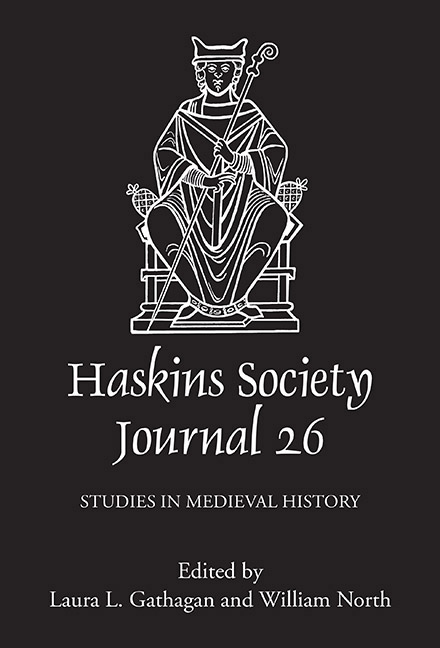Book contents
- Frontmatter
- Contents
- List of Figures
- Editors’ Note
- Abbreviations
- 1 Mores Tuos Fabricae Loquuntur Building Activity and the Rhetoric of Power in Ostrogothic Italy
- 2 A Hermeneutical Feast: Interreligious Dining in Early Medieval Conciliar Legislation
- 3 A Hypothetical Slave in Constantinople: Amalarius’s Liber Officialis and the Mediterranean Slave Trade
- 4 Welsh Kings at Anglo-Saxon Royal Assemblies (928–55)
- 5 The Diplomatics of Depredation: Reconsidering Holy Trinity Caen’s List of Losses
- 6 When Did Robert of Torigni First Receive Henry of Huntingdon’s Historia Anglorum, and Why Does It Matter?
- 7 A Coin Bearing Testimony to Duchess Matilda as Consors Regni
- 8 Fighting to be the Tallest Dwarf: Invidia and Competition in the Self-Conception of Eleventh- and Twelfth-Century Masters
- 9 Brut y Tywysogion: the History of the Princes and Twelfth-Century Cambro-Latin Historical Writing
- 10 The Use of English Annalistic Sources in Medieval Welsh Chronicles
- 11 A Franco-Danish Marriage and the Plot against England
11 - A Franco-Danish Marriage and the Plot against England
Published online by Cambridge University Press: 25 May 2021
- Frontmatter
- Contents
- List of Figures
- Editors’ Note
- Abbreviations
- 1 Mores Tuos Fabricae Loquuntur Building Activity and the Rhetoric of Power in Ostrogothic Italy
- 2 A Hermeneutical Feast: Interreligious Dining in Early Medieval Conciliar Legislation
- 3 A Hypothetical Slave in Constantinople: Amalarius’s Liber Officialis and the Mediterranean Slave Trade
- 4 Welsh Kings at Anglo-Saxon Royal Assemblies (928–55)
- 5 The Diplomatics of Depredation: Reconsidering Holy Trinity Caen’s List of Losses
- 6 When Did Robert of Torigni First Receive Henry of Huntingdon’s Historia Anglorum, and Why Does It Matter?
- 7 A Coin Bearing Testimony to Duchess Matilda as Consors Regni
- 8 Fighting to be the Tallest Dwarf: Invidia and Competition in the Self-Conception of Eleventh- and Twelfth-Century Masters
- 9 Brut y Tywysogion: the History of the Princes and Twelfth-Century Cambro-Latin Historical Writing
- 10 The Use of English Annalistic Sources in Medieval Welsh Chronicles
- 11 A Franco-Danish Marriage and the Plot against England
Summary
On 14 August 1193, the Danish princess Ingeborg arrived in Amiens and on the same day she was married to King Philip II Augustus of France. After the usual festivities the newlyweds retired to consummate the marriage. The next day Ingeborg was crowned queen of France by the king's uncle Archbishop William (of the White Hands) of Reims. However, when the coronation was over, Philip repudiated the queen and told the Danish envoys to take Ingeborg back to Denmark. They refused and immediately left France. In Compiègne on 5 November 1193, the archbishop of Reims and fifteen witnesses formally declared the couple divorced on grounds of too close affinity (consanguinitas) between Ingeborg and Philip's first wife, Isabelle of Hainaut. This became an international scandal and started twenty years of fierce litigation between the French king, the Danish kings and the papacy. Philip tried to have the marriage annulled first on grounds of affinity and later added non-consummation of the marriage and sorcery to his reasons for legal divorce. The Danes and the papacy tried to pressure Philip to acknowledge Ingeborg as his lawful wife, which he finally did in 1213.
This course of events amazed contemporaries and continues to puzzle modern historians. Why did Philip repudiate Ingeborg? The monk of Saint-Denis, Rigord, posited that the Devil rendered Philip unable to stand the sight of Ingeborg after the wedding night and/or that witchcraft temporarily had rendered Philip impotent. Other chroniclers like William of Newburgh and Roger of Howden, just as bewildered, offered other explanations for Philip's repudiation. However, in the 1190s the main argument for the divorce was that the couple was related in the fourth degree since Philip's former wife, Isabelle, and Ingeborg were assumed to be related through Charles the Good of Flanders. When the affinity claim proved inadequate to obtain a papal approval for the divorce, nine years later in 1202, Philip added to his arguments that the marriage had not been consummated due to sorcery.
Historians have traditionally argued that Philip repudiated Ingeborg for political reasons. However, in 1986 John Baldwin challenged this assumption. He argued that it was a mystery why Philip would marry a Danish princess to begin with since Philip – according to Baldwin – stood to gain nothing politically from the union.
- Type
- Chapter
- Information
- The Haskins Society Journal 262014. Studies in Medieval History, pp. 249 - 270Publisher: Boydell & BrewerPrint publication year: 2015

